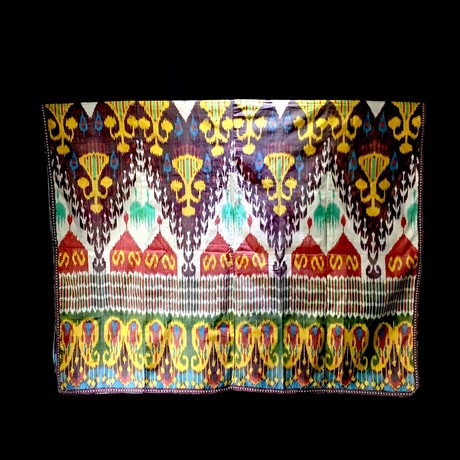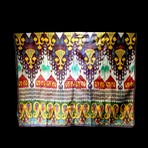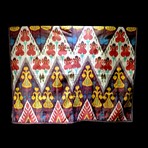Muzeion
Silk Ikat Parda // Uzbekistan Circa 19th-20th Century CE
Product Description
This beautifully embroidered Silk Ikat Parda from Uzbekistan c. 19th-20th Century CE features an elaborate, colorful, and complicated pattern that makes it a true conversation piece due to its rich history.
Ikat weaving has emerged from different parts of the world independently, however it is ikat from Uzbekistan, defined as abrabandi (“bound cloud”), which is the most captivating. The word ‘ikat’ comes from the Malaysian word ‘mengikat’ or ‘to tie’, because the loose threads are tied into bundles using grasses or wax-treated cotton to specify where the dye is able to sink in and color the thread. The threads are dyed before they are woven into the textiles.
A characteristic of ikat textiles is an apparent “blurriness” to the design. The blurriness is a result of the extreme difficulty the weaver has lining up the dyed yarns so that the pattern comes out perfectly in the finished cloth. The blurriness can be reduced by using finer yarns or by the skill of the craftsperson. Ikats with little blurriness, multiple colours, and complicated patterns are more difficult to create and therefore often more expensive. However, the blurriness that is so characteristic of ikat is often prized by textile collectors.
Product Details
- ColorsMulticolor
- Materials
Textile
- Measurements
78.75"L x 51"W x 1"H
- OriginUzbekistan
— Circa 19th-20th Century CE
— Hand-Loomed
— One Of A Kind
— Includes Certificate of Authenticity
Shipping Information
-
Shipping AvailabilityCanada, United States
-
Shipping PolicyStandard Ground Shipping
-
Ship In3-5 weeks ⓘ
-
Return PolicyFinal sale, not eligible for return or cancellation
































































 .
.